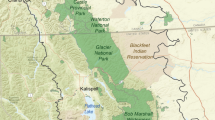ABSTRACT
The study of forest landscape change requires an understanding of the complex interactions of both spatial and temporal factors. Traditionally, forest gap models have been used to simulate change on small and independent plots. While gap models are useful in examining forest ecological dynamics across temporal scales, large, spatial processes, such as seed dispersal, cannot be realistically simulated across large landscapes. To simulate seed dispersal, spatially explicit landscape models that track individual species distribution are needed. We used such a model, LANDIS, to illustrate the implications of seed dispersal for simulating forest landscape change. On an artificial open landscape with a uniform environment, circular-shaped tree species establishment patterns resulted from the simulations, with areas near seed sources more densely covered than areas further from seed sources. Because LANDIS simulates at 10-y time steps, this pattern reflects an integration of various possible dispersal shapes and establishment that are caused by the annual variations in climate and other environmental variables. On real landscapes, these patterns driven only by species dispersal radii are obscured by other factors, such as species competition, disturbance, and landscape structure. To further demonstrate the effects of seed dispersal, we chose a fairly disturbed and fragmented forest landscape (approximately 500,000 ha) in northern Wisconsin. We compared the simulation results of a map with tree species (seed source locations) realistically parameterized (the real scenario) against a randomly parameterized species map (the random scenario). Differences in the initial seed source distribution lead to different simulation results of species abundance with species abundance starting at identical levels under the two scenarios. This is particularly true for the first half of the model run (0–250 y). Under the random scenario, infrequently occurring and shade tolerant species tend to be overestimated, while midabundant and midshade tolerant species tend to be underestimated. The over- and underestimation of species abundance diminish when examining long-term (500 y) landscape dynamics, because stochastic factors, such as fire, tend to make the landscapes under both scenarios converge. However, differences in spatial patterns, and especially species age-cohort distributions, can persist under the two scenarios for several hundred years.
Similar content being viewed by others
Author information
Authors and Affiliations
Additional information
Received 24 November 1998; accepted 17 March 1999.
Rights and permissions
About this article
Cite this article
He, H., Mladenoff, D. The Effects of Seed Dispersal on the Simulation of Long-Term Forest Landscape Change. Ecosystems 2, 308–319 (1999). https://doi.org/10.1007/s100219900082
Issue Date:
DOI: https://doi.org/10.1007/s100219900082




